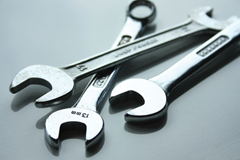Manufacturing update
 Output and productivity in manufacturing increased in the first quarter after a bleak 2009-2010 period across many sub-sectors.
Output and productivity in manufacturing increased in the first quarter after a bleak 2009-2010 period across many sub-sectors.
Manufacturing output grew by 1.2 per cent in the first quarter (January-March) this year according to the Northern Ireland Index of Production. The index, which measures output in the manufacturing, electricity, gas and water, and mining and quarrying industries, shows there was a 15.2 per cent decline during Q2 2010-Q1 2011 period, but the modest increase in the first quarter comparing well with the 0.8 per cent increase across the UK. Quarter 1’s growth contrasts with 6.4 per cent in the same quarter last year; the UK’s Q1 rate for 2011 was 4.4 per cent.
The index shows engineering and allied industries contributing most to the quarterly rise, with the sub-sector growing by 2.8 per cent between January and March. Other sub-sectors showing growth in output include basic metals and fabricated metal products (+4.0 per cent), leather, textiles and textile products (+4.6 per cent), other manufacturing (+2.8 per cent), while the manufacturing of food, drink and tobacco, which accounts for half of manufacturing sales in Northern Ireland (and half of external sales), saw a decline in output of 0.9 per cent. Output in chemicals and chemical products (which has seen growth of 16.9 per cent between Q2 2010-Q1 2011) declined by 2.4 per cent in the first quarter of this year.
Productivity has increased in the manufacturing sector, according to the index. Measured as the number of units of output produced per person per paid hour, there has been an increase of 1.4 per cent in Q1 2011, and by 5 per cent over the year. Employment in manufacturing, while up 1.6 per cent over four quarters, is slightly down for the first three months of 2011 (-0.2 per cent).
The modest rise in manufacturing comes after difficulties in recent times. The Northern Ireland Manufacturing Sales and Export Survey 2009-2010 (April to April), published last December by DETI, showed total sales declining by 0.4 per cent, compared with 4.6 per cent growth the previous year. Exports declined by 8.5 per cent, sales by 3.7 per cent, including those to the EU (including the Republic) down by 16.4 per cent, the Republic (-6.3 per cent). Sales to the rest of world did increase (+0.7 per cent), as did those to Great Britain (+8.5 per cent).
The figures in real terms, however, which take account of inflation and changes in currency values, show a bleaker picture in all these figures except total sales. The decline in export sales, in both current and constant prices, was the highest in a 10-year period. The total value of sales was estimated at £15.7 billion. 78.4 per cent of this figure was for sales external to Northern Ireland. Four-fifths of manufacturing exports were from food, beverages and tobacco (19.8 per cent) and transport equipment (18.9 per cent) sectors.
The survey revealed declines in four sub- sectors: non-metallic minerals; repair and installation of equipment; machinery and equipment not elsewhere classified; electrical equipment. Small manufacturing firms saw the greatest decline in exports (-18.6 per cent), followed by large firms (-8.1 per cent), with medium-sized manufacturing firms witnessing a 4.3 per cent drop in exports. The survey also found that SMEs in manufacturing relied on domestic markets for four-fifths of their sales, and that the more distant the market the more likely large firms are to have a greater share of the market.






